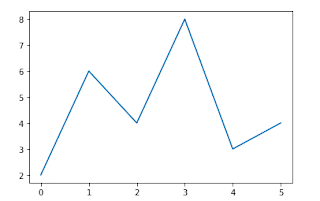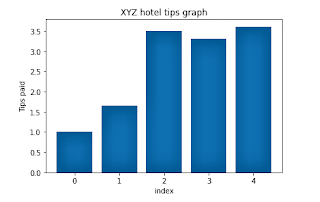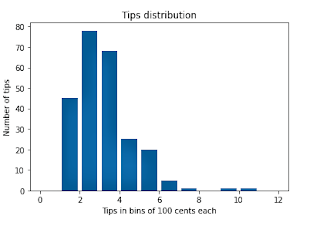Plotting and visualization with python using matplotlib
What is matplotlib?
Plotting and visualization with python using matplotlib
- A brief matplotlib API primer:
- Colors, Markers, and Line styles.
- Figures and Subplots.
- Ticks, labels, legends, and saving plots to file.
- Different plots using matplotlib, pandas, and seaborn:
- Line & bar plots.
- Histograms & density plots.
- Scatter or point plots.
- Facet grids and categorical data.
Overview:
- Making informative visualizations (sometimes called plots) is one of the most important tasks in data analysis. It may be a part of the exploratory process—for example, to help identify outliers or needed data transformations, or as a way of generating ideas for models.
- Python has many add-on libraries for making static or dynamic visualizations, we will mainly be focused on matplotlib and libraries that build on top of it. matplotlib is a desktop plotting package designed for creating (mostly two dimensional) publication-quality plots.
- The project was started by John Hunter in 2002 to enable MATLAB-like plotting interface in Python.
- Over time, matplotlib has spawned a number of add-on toolkits for data visualization that uses matplotlib for their underlying plotting. One of these is seaborn, which we will explore later in this presentation.
- With matplotlib, we use the following import convention.
- After running it in jupyter, we can try creating a simple plot.If everything is set up right, a line plot like below appear.
import pandas as pd import numpy as np import matplotlib.pyplot as plt data=np.array([2,6,4,8,3,4]) plt.plot(data)
Figures and subplots:
- Plots in matplotlib reside within a Figure object. You can create a new figure with pit.figure().
- plt.figure() has a number of options; notably, figsize will guarantee the figure has a certain size and aspect ratio if saved to disk. One can’t make a plot with a blank figure.One have to create one or more subplots using add_subplot().
- This means that the figure should be 2 x2 (so up to four plots in total), and we’re selecting the first of four subplots (numbered from 1).
- The objects returned by fig.add_subplot are Axessubplot objects, on which one can directly plot on the other empty subplots by calling each one's instance method.
fig=plt.figure() ax1=fig.add_subplot(2,2,1) ax2=fig.add_subplot(2,2,2) ax3=fig.add_subplot(2,2,3)
x=np.arange(0,3*np.pi,0.1) fig=plt.figure() ax1=fig.add_subplot(2,2,1) ax2=fig.add_subplot(2,2,2) ax3=fig.add_subplot(2,2,3) ax1.plot(np.random.randn(10)) ax2.plot(np.sin(x)) ax3.plot(np.cos(x))
fig,axes=plt.subplots(2,2) axes
Colors,Markers,and line styles:
- Matplotlib’s main plot function accepts arrays of x and y coordinates and optionallyastring abbreviation indicating color and line style.
- There are a number of color abbreviations provided for commonly used colors, but one can use any color on the spectrum by specifying its hex code (e.g.,'#CECECE’).
- One can see the full set of line styles by looking at the command help(pit.plot).
- Line plots can additionally have markers to highlight the actual data points.
help(plt.plot)
Output=
Help on function plot in module matplotlib.pyplot:
plot(*args, scalex=True, scaley=True, data=None, **kwargs)
Plot y versus x as lines and/or markers.
Call signatures::
plot([x], y, [fmt], *, data=None, **kwargs)
plot([x], y, [fmt], [x2], y2, [fmt2], ..., **kwargs)
The coordinates of the points or line nodes are given by *x*, *y*.
data=np.random.randn(30)
data
Output=array([-0.55620921, 1.15354551, 1.88428619, -0.25361657, 0.11720929,
0.99380999, -1.61673998, 0.15259621, 1.07661434, 0.57335323,
1.51775676, 2.16336357, 0.29821075, 0.80887232, -0.23170136,
-0.15509185, -2.13596732, -0.25341181, -0.81853445, -1.75597032,
-2.66753714, -1.10821393, 1.40548605, 0.06021546, -0.4025957 ,
-0.18417526, 3.20519396, -1.15411711, 0.58264083, -0.070976 ])
plt.plot(data,linestyle='--',color='g')plt.plot(data,color='y',linestyle='dashed',marker='o')
Ticks, Labels and Legends:
- The pyplot interface, designed for interactive use, consists of methods like xlim, xticks, and xticklabels. These control the plot range, tick locations, and tick labels respectively.
- To change the x-axis ticks, it’s easiest to use set_xticks and set_xticklabels. The former instructs matplotlib where to place the ticks along the data range; by default these locations will also be the labels. The rotation option sets the x tick labels at a any degree rotation.
- Lastly, set_xlabel gives a name to the x-axis 1 and set_title the subplot title.
- Legends are another critical element for identifying plot elements. One pass the label argument when adding each piece of the plot.
fig=plt.figure() ax=fig.add_subplot(1,1,1) ax.plot(data)
fig=plt.figure() ax=fig.add_subplot(1,1,1) ax.plot(data) ax.set_xticks([0,10,20,30]) ax.set_xticklabels(['zero','ten','twenty','thirty'],rotation=30,fontsize='large') ax.set_title("My plot") ax.set_xlabel("Stages")
fig=plt.figure() ax=fig.add_subplot(1,1,1) ax.plot(np.sin(x),'b--',label="Sine wave") ax.plot(np.cos(x),'c.',label="Cosine wave") ax.legend()
Saving plots to file:
- One can save the active figure to file using plt.savefig. This method is equivalent the figure object’s savefig instance method.
- For example, to save an PNG version of a figure, we need only type: plt.savefig(‘image.png')
- The file type is inferred from the file extension. So if one used .pdf instead, one would get a PDF.
- There are a couple of important options that are used frequently : dpi, which controls the dots-per-inch resolution, and bbox_inches, which can trim the whitespace around the actual figure.
plt.plot(data,color='k',linestyle='dashed',marker='o')
plt.savefig("image11.png")
- Bar plot
- Histogram
- Scatter plot
- Stack plot
- Pie plot
Plotting using Seaborn import seaborn as sns sns.set() data=np.random.randn(30) sns.distplot(data,kde=0)
I hope that you have understood this topic, I have tried my best, This is a vast topic but I have covered it in short....
Best Regards from,
msbtenote:)
THANK YOU!!!
















Join the conversation